Catholic Customs
 |
 |
 |
 |
 |
 |
 |
Passion Week & Our Lady
of Sorrows Processions
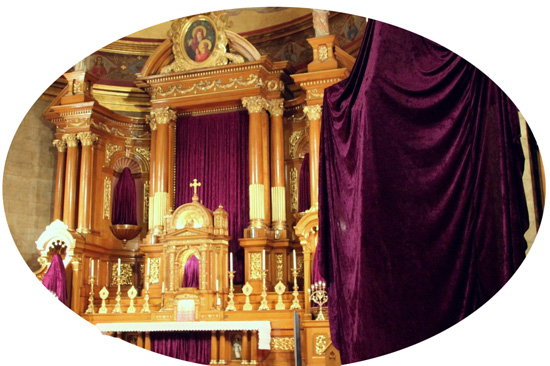
The Sunday following the joyful Laetare Sunday begins the season of Passiontide during which the Church prepares more zealously for the approaching Triduum. Our Holy Mother the Church cries out in her Matins one last call to tepid souls: “Today, if you shall hear the voice of the Lord, harden not your hearts.”
Our Catholic forefathers gravely considered the teaching in these words. From Passion Sunday onwards society spurned any display of worldliness, and those who had been negligent during the first five weeks of Lent now resolved to observe more fervently the penitential and recollected spirit of the season.
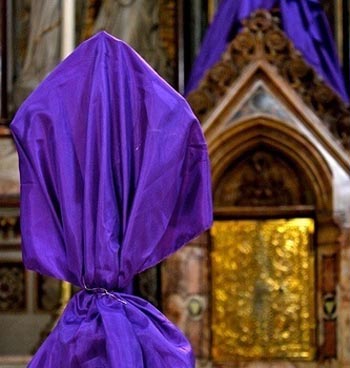
The religious symbols are covered with purple veils
The veiled statues are meant to evoke strong sentiments of sorrow and compunction in the faithful as they are forcibly reminded of the fury of the Jews and the malice of sin that caused Our Lord to hide. Thus in the past every Catholic community was transformed by this visible sign of mourning.
A somber and more recollected atmosphere filled the churches and the public squares of villages and cities on Passion Sunday, a silence so profound in the Slavic countries that the peoples called it "Quiet Sunday."
Pious Catholics took on more severe penances and fasts and spent longer times in prayer and meditation on the Passion to prepare themselves for the holiest week of the year. Those with means redoubled their alms to the poor to unite with Our Lord during the weeks of Passiontide, when He allows the graces of His Passion to flow freely upon sinners. (1)
Carling Sunday
In England, Passion Sunday was often called Carling or Carlin Sunday because it was a traditional day to eat carling peas and distribute them to friends and the poor. People from Northern England and the Scottish Lowlands prepared these dried peas by soaking them overnight and frying them in butter or boiling them to form a soup or porridge.

Passion Sunday pea porridge, a symbol of mourning; below, medieval ladies gathering herbs
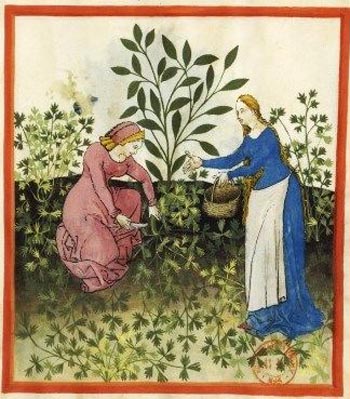
According to one author, the origin of the custom of eating and distributing peas was based on the penitential practice performed by the disciples of Our Lord of picking ears of grain and rubbing them in their hands. (2) Catholics in later years often performed similar penances with grains or peas; one penance was to place hard peas in the shoes. In some English towns as well as in parts of France, the streets were strewn with hard peas on Carlin Sunday as a reminder to villagers to make penance. (3)
The plants that blossomed at this time of the year were also associated with the Passion by Catholics of the past who sought the symbolic meanings of the changing flora and fauna of each season. In Northern England, Bistort (Bistorta officinalis) began to show its green leaves at this time of year and, for that reason, received the name of Passion Dock. The people included it in their Passion Sunday meal of Passion Pudding, a mixture of nettles, bistort, barley, and onions.
One particularly symbolic plant native to the Americas is the Passion Flower. The Spanish and Portuguese missionaries saw this exotic flower as the perfect means to teach the Indians about the Passion of Christ: "The Passion Flower long has blow'd/ To betoken us signs of the Holy Rood." (4)
A symbolic meaning was found in each of its features and forms, as is explained here. Passion flowers were introduced to Europe in the 18th century and soon were found in private gardens from Spain to England.
Feast of the Seven Sorrows
Friday of Passion Week is the Feast of the Seven Sorrows of Our Lady. The peoples of Central Europe honor Our Lady on this day by eating a Siebenkrautersuppe (Seven Herb Soup), symbolic of the Seven Sorrows of Our Lady. The seven bitter herbs commonly used are parsley, watercress, nettle, leeks or chives, spinach, sour clover and primrose or yellow cowslip.
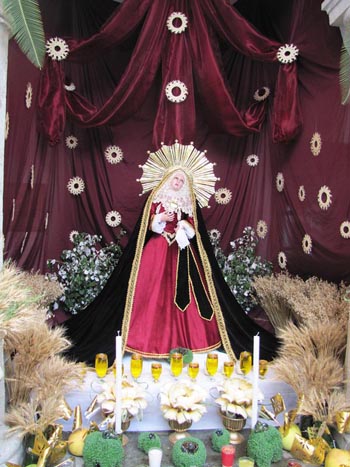
Shrine to Our Lady of Sorrows in Mexico
“On Viernes de Dolores altars in churches and even in private houses are set with low bowls of newly sprouted wheat, which washes gently over steps and floors in pale spring gold. Above it are tall candles, very ornate; and rows of oranges stuck with gold-leaf flags stand on railings and hang from ceiling lamps. A fluttery gold shrine for the sorrowful Mother in her heavy black.” (5)
Every item on the altar is symbolic: lilies represent Our Lady’s purity, bitter oranges depict her sorrow, gold flags and balls show the joy in the Resurrection, red hearts signify the Sacred Heart, sprouted wheat represents the Holy Eucharist, green stalks of chamomile symbolize humility, the yellow chamomile flowers represent the beauty of Our Lady’s body and soul, and urns filled with liquid and glass balls stand for Our Lady’s sweet tears. (6)
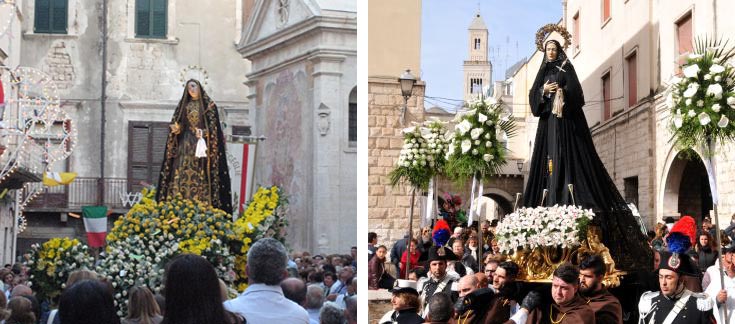
Processions to Our Lady of Sorrows in Italy
Thus does the Church enter into these two most solemn weeks of the year. May these examples from Passion Weeks of the past inspire us to actions that conform to the sentiments of the Church and prepare us for a fervent Holy Week.
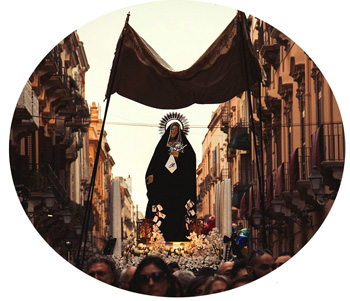
Procession of Our Lady of Sorrows in Italy
- Francis X Weiser, The Easter Book (San Diego, California: The Firefly Press, 1996), p. 49.
- http://www.foodsofengland.co.uk/carlinpeasorbrownbadgers.htm
- E. I. Robson, A Guide to French Fêtes (London: Methuen and Company, 1930), p. 55.
- W.M. Hackwood, Christ Lore: Being the Legends, Traditions, Myths, Symbols, Customs, and Superstitions of the Christian Church (London: Elliot Stock, 1902), p. 159.
- Erna Fergusson, Fiesta in Mexico (New York: Alfred A. Knopf, 1934), p. 237.
- http://www.allthesaintsyoushouldknow.com/decoding-our-lady-of-sorrows-in-mexico-city

Posted March 27, 2023
______________________
______________________
 |
 |
 |
 |
 |
 |


